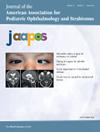Preventable vision loss in children with Coats disease
IF 1.2
4区 医学
Q3 OPHTHALMOLOGY
引用次数: 0
Abstract
Purpose
To describe the prevalence and risk factors associated with amblyogenic refractive error in children with Coats disease.
Methods
The medical records of children (<18 years of age) with unilateral Coats disease treated at a single tertiary care center were retrospectively reviewed. Data collected included patient demographics, ocular examinations, and treatments. Outcomes included the prevalence and factors associated with amblyogenic refractive error.
Results
A total of 50 children (82% male) were included; of these, 37 (74%) had refractive data to review. The median age at presentation was 5 years (IQR, 2-10). The Coats disease classification was stage 1 in 1 (2%), stage 2 in 29 (58%), and stage 3 or greater in 20 (40%). Most children (76%) had at least one visit with a pediatric specialist; the rest were only seen by a retina specialist. Among patients with refractive data, amblyogenic refractive error was identified in 46%. Glasses were prescribed to 50% of children. Children diagnosed at an earlier age had increased odds of amblyogenic refractive error (OR = 0.72; 95% CI, 0.57-0.91; P = 0.006) than those diagnosed at an older age.
Conclusions
Our results suggest that amblyogenic refractive error is prevalent among children with Coats disease, and refractions are not always performed. There is a need to coordinate care between pediatric and retina specialists caring for children with Coats disease to ensure timely diagnosis of amblyogenic refractive error to optimize visual outcomes in this population.
柯茨病儿童可预防的视力丧失。
目的:描述科茨病儿童弱视性屈光不正的患病率和相关风险因素:结果:共纳入 50 名儿童(82% 为男性)的病历:共纳入 50 名儿童(82% 为男性),其中 37 名儿童(74%)有屈光数据可供审查。发病时的中位年龄为 5 岁(IQR,2-10 岁)。1 名儿童(2%)的科茨氏病为 1 期,29 名儿童(58%)为 2 期,20 名儿童(40%)为 3 期或以上。大多数患儿(76%)至少接受过一次儿科专家的诊治,其余患儿只接受过视网膜专家的诊治。在有屈光数据的患者中,46%的患者被确认为弱视性屈光不正。50%的儿童配戴了眼镜。与年龄较大的儿童相比,年龄较小的儿童被诊断出弱视性屈光不正的几率更高(OR = 0.72;95% CI,0.57-0.91;P = 0.006):我们的研究结果表明,弱视性屈光不正在科茨病患儿中很普遍,而屈光检查并不总是进行。有必要协调儿科专家和视网膜专家对高兹病患儿的治疗,以确保及时诊断弱视性屈光不正,从而优化该人群的视觉预后。
本文章由计算机程序翻译,如有差异,请以英文原文为准。
求助全文
约1分钟内获得全文
求助全文
来源期刊

Journal of Aapos
医学-小儿科
CiteScore
2.40
自引率
12.50%
发文量
159
审稿时长
55 days
期刊介绍:
Journal of AAPOS presents expert information on children''s eye diseases and on strabismus as it affects all age groups. Major articles by leading experts in the field cover clinical and investigative studies, treatments, case reports, surgical techniques, descriptions of instrumentation, current concept reviews, and new diagnostic techniques. The Journal is the official publication of the American Association for Pediatric Ophthalmology and Strabismus.
 求助内容:
求助内容: 应助结果提醒方式:
应助结果提醒方式:


